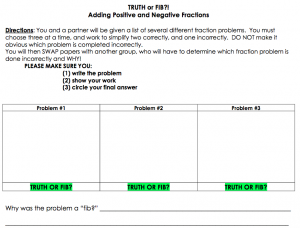Truth or Fib?!
Okay everyone, let’s talk ERROR ANALYSIS! Educational researcher guru Robert Marzano found that error analysis promotes higher level thinking as it gets students to analyze work, identify errors, and be able to explain what is incorrect. I absolutely love having my students do error analysis problems. It gives them a chance to dig a little deeper into the problem, and they are being given a different kind of challenge. This type of instruction helps the students to think about solving a problem in a unique way. It allows them to challenge their own thinking.
The textbooks that I use in my classroom are great because they include error analysis problems. I often assign them for homework problems. However, I have a different trick up my sleeve. This activity is one that I usually use in the classroom. It is called “Truth or Fib,” and can be set up and used in many different ways. Here’s one way to implement Truth or Fib:
- I first provide my students with a list of problems (depending on the topic)
- The students also receive a worksheet (this can also be done right in their own notebooks). An example of part of the worksheet can be found below.

- The students each choose three problems from the list (they work independently at this part). They solve two of the problems correctly, and one of them incorrectly (they get to choose which are correct and which are incorrect).
- After each student completes his/her problems, he/she swaps papers with a partner. They then look over each other’s problems and determine which two are truth, and which one is the fib. Once they identify the ‘fib,’ they must explain why it is a fib and redo the problem so that it is correct.
I absolutely love having the students choose which problem they want to do incorrectly, as well as give them the opportunity to really solve it wrong. In my opinion (as well as based on conversations my students have), this really gives them a chance to think about what students would typically do incorrectly with that problem. It helps them to be mindful of that mistake in hopes that they won’t make the same error on an assignment or assessment.
Now, as I mentioned before, truth or fib can be implemented in many different ways. Another thing that I have done is give students a topic (such as solving equations) and have had them create their own problems, solving two of them correctly and one incorrectly.
Another idea that would involve a whole class activity would be to pass out one problem to each student in the class. Then, that student can decide whether he/she wants to do the problem correctly or incorrectly. Each student can fill out a chart similar to the following:
| My problem: | Solved Problem:
|
| a) Did you make your problem correct or incorrect?
|
b) If you made your problem incorrect, what did you do wrong? |
| c) If you made your problem incorrect, solve it again to get the correct answer.
|
d) If you made your problem correct, solve it incorrectly and answer question b. |
Once each student has a chance to fill out the chart, you can have them leave the problems at their desks and cover up the bottom portion (a – d). Then, students can rotate around the room determining whether the problems at each desk are “truths” or “fibs.” They can check their own answers by uncovering the bottom portion and comparing what they got with the paper they were looking at (you can purchase the whole activity right here: Truth or Fib Whole Class Activity).
I hope you enjoyed this little twist on error analysis. I am interested to hear about what you do in your own classroom to have students analyze, identify, and correct errors! Let us all know by posting a comment!